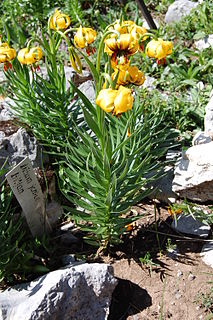
In botany, a bulb is structurally a short stem with fleshy leaves or leaf bases that function as food storage organs during dormancy.

Lilium is a genus of herbaceous flowering plants growing from bulbs, all with large prominent flowers. Lilies are a group of flowering plants which are important in culture and literature in much of the world. Most species are native to the temperate northern hemisphere, though their range extends into the northern subtropics. Many other plants have "lily" in their common name but are not related to true lilies.

Lilium bulbiferum, common names orange lily, fire lily and tiger lily, is a herbaceous European lily with underground bulbs, belonging to the Liliaceae.

Lilium longiflorum, often called the Easter lily, is a plant endemic to both Taiwan and Ryukyu Islands (Japan). Lilium formosana, a closely related species from Taiwan, has been treated as a variety of Easter lily in the past. It is a stem rooting lily, growing up to 1 m high. It bears a number of trumpet shaped, white, fragrant, and outward facing flowers.

The scarlet lily beetle, red lily beetle, or lily leaf beetle, is a leaf beetle that eats the leaves, stem, buds, and flowers, of lilies, fritillaries and other members of the family Liliaceae. It lays its eggs most often on Lilium and Fritillaria species. In the absence of Lilium and Fritillaria species, there are fewer eggs laid and the survival rate of eggs and larvae is reduced. It is now a pest in most temperate climates where lilies are cultivated.

Lilium philadelphicum, also known as the wood lily, Philadelphia lily, prairie lily, or western red lily, is a perennial species of lily native to North America.

Lilium martagon, the martagon lily or Turk's cap lily, is a Eurasian species of lily. It has a widespread native region extending from Portugal east through Europe and Asia as far east as Mongolia.

Lilium henryi, sometimes called tiger lily or Henry's lily, is a native lily of the mountains of central China. The flowers are orange, spotted black, and unscented. The petals are recurving, and eventually resemble those of the more widespread Turk's-cap lily.

Lilium speciosum is an East Asian species of plants in the lily family. It is native to southern Japan and southern China, where it can be found at elevations of 600–900 metres (2,000–3,000 ft). It is sometimes called the Japanese lily though there are other species with this common name.

Lilium regale, called the regal lily, royal lily, king's lily, or, in New Zealand, the Christmas lily, is a species of plant in the lily family, with trumpet-shaped flowers. It is native to the western part of Sichuan Province in southwestern China, and cultivated elsewhere as an ornamental. It was introduced to England in 1903 by Ernest Henry Wilson.

Lilium canadense, commonly called either the Canada lily, wild yellow-lily, or the meadow lily, is a native of eastern North America. Its native range extends from Ontario to Nova Scotia south to Georgia and Alabama. It is most common in New England, the Appalachian Mountains, and the Canadian Maritimes. It is also cultivated as an ornamental in Europe and other places.
Tiger lily or Tiger Lily may refer to:

Lilium pyrenaicum is native to montane regions, mainly the Pyrenees, from Spain and eastwards, with the range extending into the Caucasus. It grows up to 1.3 m high. It bears up to 12 Turks-cap shaped flowers. These are yellow, orange or red, and unpleasantly scented.
Turban lily is a common name for several plant species and may refer to:

Lilium nepalense, the lily of Nepal, is an Asian plant species in the lily family. It is native to the Himalayas and nearby regions: northern Thailand, northern Myanmar, Assam, Bhutan, Sikkim, Nepal, Uttarakhand, Tibet, and Yunnan. It can be found growing on wet forest borders at 1,200 to 3,000 m.

Lilium bosniacum is a lily native to Bosnia and Herzegovina. It's also known as Zlatni Ljiljan and Bosanski Ljiljan.

Lilium carniolicum, commonly called golden apple or Carniolan lily, is a lily native to the Balkans, as well as to Austria and northeastern Italy. The species is named after the historical region Carniola, comprising parts of modern-day Slovenia, where it is most abundant.

Lilium maculatum is a plant in the lily family native to Japan.

The Rennsteiggarten Oberhof is a botanical garden specializing in mountain flora, located in Rennsteig at Am Pfanntalskopf 3, Oberhof, Thuringia, Germany. It is open daily in the warmer months; an admission fee is charged.

Lilium monadelphum is a bulbous plant native to Crimea and to North and South Caucasus.


















